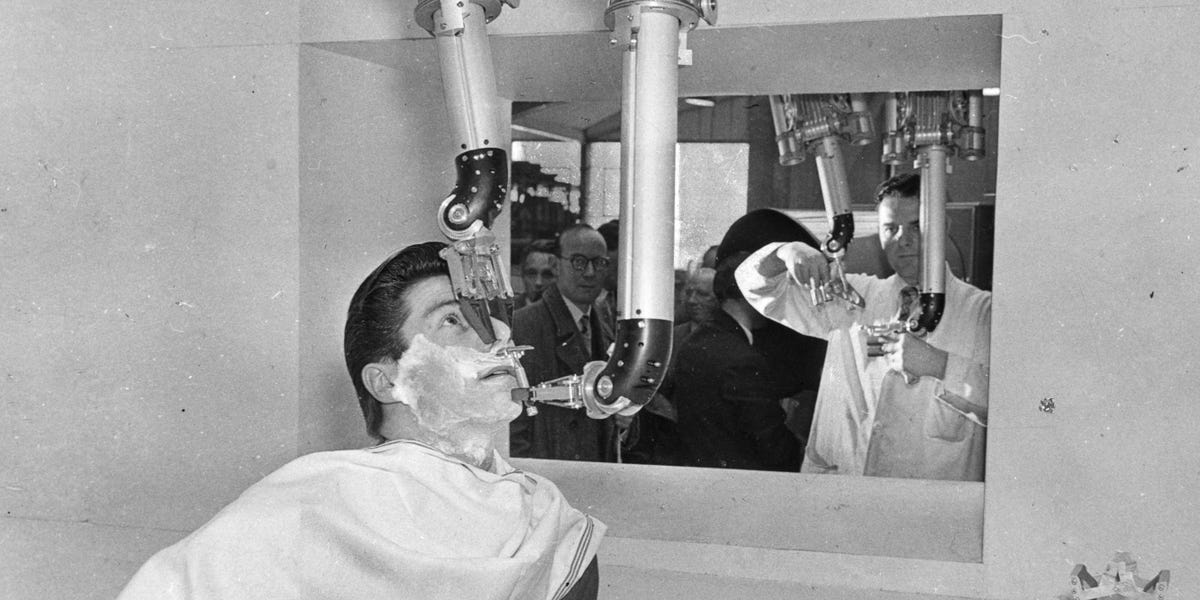10 wacky inventions that should have never existed
Rocket bikes, the world's first "smartwatch" and a doughnut dunker? Not every idea can be a great idea, as evidenced by these ridiculous vintage inventions.

The Hulton Archive lifts the lid on the world's craziest inventions
Rocket bikes, dog restrainers, doughtnut dunkers and the world's first computer watch? How could those ideas ever take off?
As one of the world's largest private archives, the Hulton Archive is full of incredible photos of yesteryear's most wacky inventions. But the extensive collection of 130 million images holds a few pearlers and shows that not every idea is always a great idea.
Together with Matt Butson, vice president of Hulton Archive, and Getty Images, we've plucked some of the most obscure, unusual inventions from throughout the last century that perhaps should have never existed at all.
Dog-restraining device
Humans domesticated dogs thousands of years ago, but it took until the 1940s for someone to create this mechanical monstrosity: An extendable arm to restrain man's best friend. It's the quintessential invention that we didn't need because, well, Mary Delaney had patented the idea for a dog leash some 40 years earlier in 1908.
Cat-Mew Machine
A Japanese invention, the Cat-Mew machine was built to frighten away house rodents, of course. With its 2-watt motor powering an automated mew and flashing cat eyes, this invention seems custom built for people who've never heard of mouse traps. Either that or its creators felt really, really bad about the poor pests.
It might not have taken off, but I could definitely see this on display in a modern hipster coffee shop.
The exploding rocket bike
Before Elon Musk, there was German engineer Richter Raketenrad. In 1931 he built a rocket bike that had 12 rockets mounted to its back wheel, giving it a whole lot of power.
As Butson explains, "This allowed him to reach a speed of 90 kph before it exploded and threw him off the bike, where he suffered a few scrapes. Suffice it to say I think this invention died on that day."
The mind machine
Humans are curious about brains and their workings, which led to this hulking unit's development. Seen here in 1907, the Lavery Electric Automatic Phrenometer supposedly measured brain activity. But in reality, it just studied the way one's head was shaped.
This woman doesn't look too enthused about the whole operation. But if you told me to stand on a box and lower a nightmarish hairdryer on top of my skull, I wouldn't be either.
Doughnut Dunker
An anti-drip doughnut stick! Never get your fingers wet while devouring the scrumptious circular delight with the "Doughnut Dunker". Russell E. Oakes, a man with much better table etiquette than I, came up with this one in 1955 to prevent doughnut mess. Don't think it would have made Oakes too much dough, though.
Spaghetti Aid
Russell E. Oakes didn't stop at the doughnut dunker, featuring again in the Hulton Archive's extensive collection with this: The Spaghetti Aid.
This tool was designed to make it "easier" to demolish a nice big bowl of spaghetti. By turning the lever, the fork would spin, winding the spaghetti strands around the metal. We salute your genius, Russ, but we can't see how this made spaghetti-eating any simpler.
Typing Aid
It looks ridiculous, but this headstrap contraption was developed to aid the disabled in using a typewriter.
"While not particularly stylish, it was a forward-thinking invention for 1951 that suffered primarily from the difficulty of using your head to type," Butson says.
Robotic shaving arms
Shaving. What a pain. In 2018, we don't have any robots that shave our faces and armpits and legs, but why not? In 1957, these remote-controlled arms, at use in a nuclear research facility, were used to shave a man's face, demonstrating their dexterity and safety. I still have to shave my face the old-old-fashioned way -- with my hands and a sharp razor.
Hurry up and fix this, science.
Pulsar computer watch
Surely an idea that will divide opinion: A computer in a watch. Will this ever take off?
With an LED screen and a calculator onboard, this invention was more than just the sum of its parts. Here it's on display at the International Watch and Jewellery Trades Fair at Wembley, London in 1977 -- but these days its more likely to appear on Antiques Roadshow.
Toshiba View Phone
Sometimes, you're just way ahead of the curve. 40 years before the iPhone, Toshiba was tinkering with some ancient FaceTime tech in its Model 500 View Phone.
"While not practical in use, it's interesting to see that video communication was an idea being tinkered with this long ago," says Butson.
One positive of the View Phone is the fact that the camera is right next to the screen, but the phone is far too big to lift up. That means when you call your parents, you wouldn't get the up-the-nose angle everybody dreads.

